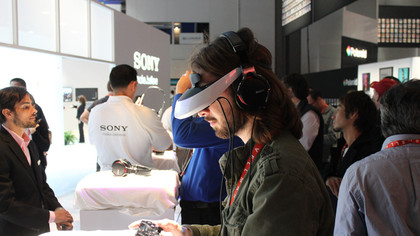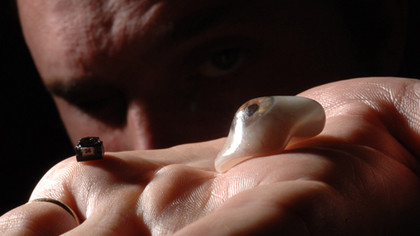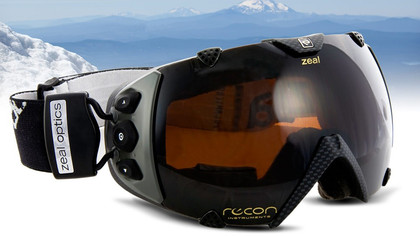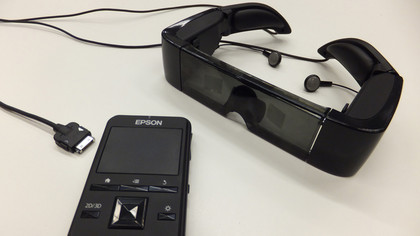8 best augmented reality headsets: Google Glass and more
AR is getting ever more popular. Go Go Gadget glasses!
It links to a smartphone for calls and text messages, but that's via a slightly messy wireless remote, which can be clipped onto the Airwave or worn on a wrist, but either way it's a tad old-school when compared to the voice interaction and dictation imminent via Google Glass.
5. Sony HMZ-T1 Personal 3D Viewer, £700

The most elaborate personal viewer to reach the consumer market so far, this headset is about immersive 3D and even uses high-resolution OLED panels. A two-piece set comprising the 3D viewer itself and an HDMI dual output switcher, a single cable links the two, delivering sound, vision and power.
Any HDMI source can be connected, from a set-top box to a Blu-ray player, so this is best viewed as an alternative to a bigscreen TV or home cinema. The screen appears to be 750-inches in diameter, and mimics a 'real' cinema by tilting the OLED panels to emulate that big-screen effect.
By keeping out any external light, the illusion of a large screen is surprisingly convincing, and there's genuine high definition clarity to be had. The refresh rate of OLED is lightning-fast (just 0.01 milliseconds) so there's no blur or 3D crosstalk - and the sound quality is awesome, but it's hardly flown off shelves.
Read our full Sony HMZ-T1 Personal 3D Viewer review
6. EyeBorg Eyecam 3.0, £TBC

It's resolutely a prototype rather than a finished product, but does EyeBorg represent the logical next step for smart glass?
It's actually a rather basic idea; strap a wireless video camera and a transmitter to a prosthetic eye, and insert into an otherwise empty eye-socket. The 'digital eye' then sends a live video stream from a direct human perspective to a smartphone or computer.
OK, so Google Glass can probably film video from an almost identical perspective, and we can't imagine (many) people will gauge their own eyes out to get an Eyecam, but, hey, it glows red in the dark! As an early slice of trans-human self-augmentation, the Eyeborg is, er, visionary.
7. Zeal Optics Transcend GPS Goggles, £300

With wearable tech so far dominated by sensor-based gadgets for runners like the Nike FuelBand and Fitbit, this is an early version of what's bound to be an avalanche of smart glass apps for skiers and athletes.
This altimeter and GPS-powered Heads Up Display has SPPx polarized photochromic lenses to adjust to the light intensity on the slopes and lessen glare, but that's just the start. It simultaneously shows the wearer a read-out for distance travelled, speed, altitude, stopwatch and temperature on a LCD display that appears to be about two metres away.
Après-ski, a USB slot lets you transfer activity data to a computer, and a Google Map. Jump on a few generations and add both smart glass and a 4G signal and we reckon the Transcend will tell the savvy skier what he/she really needs to know by showing a virtual red line on the piste that plots the course to the next vin chaud. Alternatively, such a system could help snowboarders from crashing into … everybody.
8. Epson Moverio BT-100, £700

Printers, projectors … and portable video glasses? An unexpected, though not particularly mind-blowing contribution to the genre comes from Epson, whose Moverio BT-100 is a decidedly first-gen attempt.
Aimed at frequent flyers who don't want to either watch the terrible LCD screen in the seat or crane their necks at a tablet, the Moverio BT-100 essentially creates a 320-inch display for watching movies.
It's got 1GB storage, a SD Card slot and runs an Android OS, though where it differs from other attempts at video-specs is its design; using smoked-glass that's easily transparent, it's possible to wander around while watching a film - though its enormous movie screen, while also transparent, creates a bit of a blind-spot.
Where it falls down is its lack of noise-cancelling headphones, which is a must at 40,000ft. The battery lasts for six hours.
Get daily insight, inspiration and deals in your inbox
Sign up for breaking news, reviews, opinion, top tech deals, and more.
Jamie is a freelance tech, travel and space journalist based in the UK. He’s been writing regularly for Techradar since it was launched in 2008 and also writes regularly for Forbes, The Telegraph, the South China Morning Post, Sky & Telescope and the Sky At Night magazine as well as other Future titles T3, Digital Camera World, All About Space and Space.com. He also edits two of his own websites, TravGear.com and WhenIsTheNextEclipse.com that reflect his obsession with travel gear and solar eclipse travel. He is the author of A Stargazing Program For Beginners (Springer, 2015),
